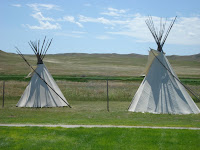July 20. We went to Agate Fossil Beds National Monument to learn about the fossils discovered there. Back in 1862 when the Homestead act was passed, it gave anyone who wanted 160 acres, to go west and occupy it for two years and it became theirs. James Cook did so, getting his 160 acres near what is now Harrison, Nebraska. In 1880, while riding between 2 buttes on his ranch, he discovered some bones. Over the next 30 years, Paleontologists from back east, unearthed a treasure trove of bones, some never seen before. They are all from the Miocene era, about 23 million years ago. The climate back then was very similar to today's Serengeti Desert in Africa. The biggest discoveries were Rhinoceros, Moropus, (something like a horse with claws), and Daphoenodon, which is referred to as beardogs, because the look like a cross between a large dog and a bear. We viewed piles of these bones and several reconstructed animals made from casts of bones, like you see in a museum.
James Cook was also a friend of the local Indian tribe, the Ogalala Sioux, and their chief Red Cloud. Although Sitting Bull, Crazy Horse and Geronimo are known for their killing, Red Cloud was the most followed and respected of all the western chiefs. Red Cloud knew that the white men would soon outnumber the Indian, so he persuaded other Indians to accept this, sign treaties, and live peacefully. Red Cloud even took a train, on several occasions, to Washington, D.C. to speak with the U.S. officials, to get Indians what they deserved. Red Cloud and other local Indians befriended James Cook and gave him many gifts, 200 of which are displayed in the James Cook Gallery at Agate.
Trivia: In every major battle that Crazy Horse was involved in against the white man and their calvary, Crazy Horse and his warriors, never left the field of battle until every white men was dead. He was 3-0 in major encounters, including Custer's last stand.
 |
| Agate Fossil Beds |
 |
| Carnegie & University Buttes |
 |
| Rhino and Beardog bones |
 |
| more bones |
 |
| Rhinoceros's tracks |
 |
| Ogalala Sioux Teepees |






No comments:
Post a Comment